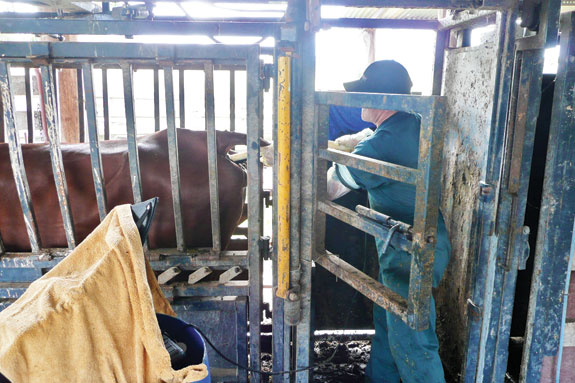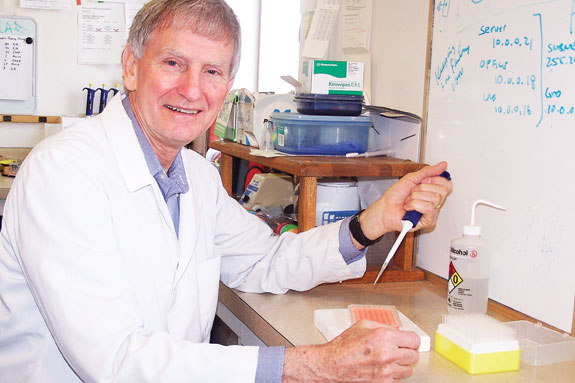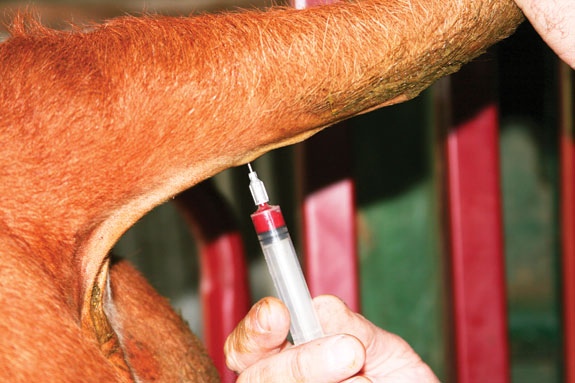Extension-arm ultrasound
Trans-rectal ultrasound allows the veterinarian to visualize the embryo or fetus and offer additional information beyond what can be gleaned by rectal palpation, including sex of the fetus, according to Dr. Ram Kasimanickam of Washington State University.
“Another advantage is that ultrasound can detect pregnancy with high accuracy as early as 26 days following breeding,” he says.
There are two ways that a veterinarian can do the ultrasonography: with the traditional arm-in rectal probe or the newer extension-arm probe that eliminates the need for putting an arm into every cow.
“This technology was introduced to clinicians about 12 years ago. The big advantage is that it is not as hard on the veterinarian’s arm as palpating or arm-in ultrasonography,” he explains.
“It has an oscillating probe so you don’t have to rotate the rod to view the uterus and its contents.

The person using this extension-arm probe has to be cautious, however, due to risk of damaging the rectum with sudden, unexpected movement.
If the cow jumps around when you are holding the probe in place, there is some risk for a rectal tear,” says Kasimanickam.
Dr. Andrew Bronson of Alberta, Canada and his partner Bruce Hill recently developed an improved version of this technology called Repro-Scan that uses a convex rectal probe that produces a larger image.
“This is like the difference between a rifle and a shotgun for hitting a target,” explains Bronson.
“When we started our company, there were no beef ultrasound units available with the convex probe. We created one and put it into a portable case,” he says.
The biggest advantage to the extension-arm unit is that it is much easier on the person doing the pregnancy testing.
Palpation and arm-in ultrasound put a lot of wear and tear on veterinarians who do a lot of this. “My partner and I preg-checked more than 150,000 heifers by ultrasound in 2½ years, when the Canadian border was reopened and nothing pregnant was allowed to be exported.
We would not have been able to do this many animals without extension-arm ultrasound,” Bronson says.
“During the busy season with beef cattle, veterinarians must be able to go through a lot of cows quickly.
The average height of veterinarians is dropping (there are more female veterinarians now) and it’s harder for them to do rectal palpation, and there are fewer interested in taking the time to learn to palpate,” he says.
Many of the older veterinarians who were really good at palpating, and being able to age the fetus, are gone now or retiring.
“Most of the young vets like technology and understand it, and can do a good job of aging the pregnancies with ultrasound.”
His company works with reps in Canada and also in Montana, Idaho, California and Missouri.
“We provide demo equipment and training courses for veterinarians and producers. The Graham School in Kansas (which is more than 100 years old) teaches cattlemen how to do AI, rectal palpation and we put on a course there using ultrasound, with another one scheduled this September,” says Bronson.
“There are various types of ultrasound equipment and they all do a certain job. In the beef industry we need the ability to be accurate and save our arms – and this particular technique is easier to learn than palpation.”
Regarding cost, Bronson doesn’t charge any more for this service than for palpation. “It does the same job I was able to do with my hand.
But if the client wants accurate fetal aging, which takes more time with ultrasound, then I charge more.”

Blood testing
One of the first blood tests was developed by Dr. Garth Sasser from the University of Idaho.
He discovered a protein called Pregnancy Specific Protein B, produced by the placenta and detectable in blood.
He started a company called BioTracking and created a blood test called BioPRYN (Pregnant Ruminant Yes/No).
The test became commercially available for cattle in 2002.
According to Jeremy Howard, marketing manager of BioPRYN, there are 25 labs that process blood samples.
Advantages of the blood test over palpation include being able to detect pregnancy a little sooner with better accuracy.
The blood test is always more accurate (on whether the cow is pregnant or open) than rectal palpation.

It can be done more quickly and easily, taking a blood sample from a vein under the tail, with less trauma and risk to the animal.
The blood samples can be taken quickly and you can do a lot more animals at one time.
It’s sometimes difficult to find a veterinarian to do palpation and/or schedule one during busy times of year.
Ranchers can easily learn how to take blood samples themselves.
On ranches located a long distance from a vet, the cost of a farm call makes palpation more expensive than the blood test. Samples are shipped to a lab, with results sent back by phone, fax or e-mail.
Ultrasound is often expensive and requires the proper equipment and electricity. For the blood test all you need is a syringe and needle.
“We can also do our BVD test from those same samples,” says Howard.
Some beef producers use the blood test on heifers, 30 days after pulling the bull, or after synchronizing and breeding them by AI Any heifers that are open can then be sold at the peak of the open heifer market – and before the market drops toward fall when everyone is selling cull cattle.
Segment advantages
The blood test is an excellent tool if a rancher waits a couple weeks after AI breeding before putting a cleanup bull with the cattle.
With this test you can tell which ones conceived to the AI breeding and which ones were bred later to the cleanup bull.
Breeders using embryo transfer can check recipient cows quickly to determine which ones are pregnant and have another chance to use the ones that did not take.
Feedlot heifers can be checked upon arrival to determine if they are pregnant. The test is also useful in certain feeder/stocker situations and sale barns.
Some sale barns blood test all cows that go through and can market them more efficiently.
For instance, after using blood tests one auction owner in Texas found that 35 to 40 percent of cows being called open by a veterinarian during palpation were actually pregnant – especially the ones that had been bred less than two months prior to checking them.
By knowing they are pregnant he can sell them as bred cows rather than as open cows for slaughter.
Improvements in the test during the past several years have made it accurate as early as 28 days post-breeding and 73 days after calving. The cost is $2.50 per blood sample.
Options for testing
Two other blood tests are available besides the BioPRYN test. One is done by Genex called DG29.
This test targets a different protein in the blood but works on the same principle. According to Laurie Lancaster of AgSource Laboratories in Jerome, Idaho, the DG29 test is accurate as early as 29 days post-breeding and any time after 90 days postpartum.
“There are two labs that process the blood samples: the AgSource Laboratories located in Menomonie, Wisconsin, and our lab here in Jerome.
We also have a milk test available, which is probably more practical for dairy cows but can also be used in beef cattle.
With a milk sample we can determine pregnancy with accuracy any time after 35 days post-breeding and 60 days post-calving,” says Lancaster.
The other blood test is done by IDEXX Laboratories, with headquarters in Westbrook, Maine. According to Frank Winslow, director of worldwide marketing for IDEXX, this test was launched in August 2011, using ELISA assays to check for pregnancy-associated glycoproteins (PAG).
The IDEXX test is accurate at 60 days postpartum and 28 days after breeding. There are multiple labs around the country that can process the blood samples.
“This test delivers 99.3 percent sensitivity and up to 95.1 percent specificity after breeding, so clients can know with more than 99 percent certainty that a cow is open,” says Winslow.
Disadvantages to any blood test include having to wait a couple days for results. If you need to know immediately (deciding whether to vaccinate/deworm/delouse the cow or sell her) when she goes through the chute, the blood test is not a practical option.
It also cannot tell you how far along the pregnancy is, nor the sex of the fetus.
“The disadvantage of any pregnancy test (especially when checking during the first 35 to 60 days of gestation) is that it can only tell you what’s going on at that point in time,” explains Kasimanickam.
The cow may lose the pregnancy after you checked her – and come up open the next calving season. ![]()
Heather Smith Thomas is a freelance writer based in Idaho.
PHOTO
TOP RIGHT and MIDDLE TOP: David Bronson using the extension arm ultrasound portable unit to check cows
MIDDLE: Dr. Garth Sasser discovered the pregnancy-specific protein and developed the first commercial blood test for cattle.
BOTTOM: A blood sample is taken from the big vein under the cow’s tail. Photos courtesy of Heather Smith Thomas.






